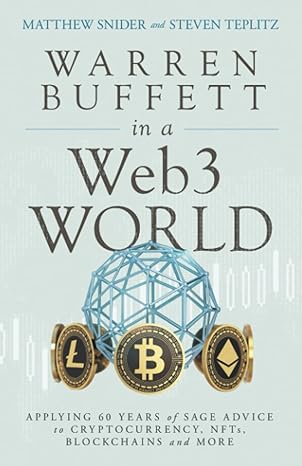Question
You recently graduated from college, and your job search led you to S&S Air. Since you felt the companys business was headed skyward, you accepted
You recently graduated from college, and your job search led you to S&S Air. Since you felt the companys business was headed skyward, you accepted their job offer. As you are finishing your employment paperwork, Chris Guthrie, who works in the Finance Department, stops by to inform you about the companys new 401(k) plan. A 401(k) is a type of retirement plan offered by many companies. A 401(k) is tax deferred, which means that any deposits you make into the plan are deducted from your current income, so no current taxes are paid on the money. For example, assume your salary will be $30,000 per year. If you contribute $1,500 to the 401(k) plan, you will pay taxes only on $28,500 of income. No taxes will be due on any capital gains or plan income while you are invested in the plan, but you will pay taxes when you withdraw the money at retirement. You can contribute up to five percent of your salary to the plan. As is common, S&S Air also has a five percent match program. This means that the company will match your contribution dollar-for-dollar up to five percent of your salary, but you must contribute to get the match. The 401(k) plan has several options for investments, most of which are mutual funds. As you know, a mutual fund is a portfolio of assets. When you purchase shares in a mutual fund, you are actually purchasing partial ownership of the funds assets, similar to purchasing shares of stock in a company. The return to the fund is the weighted average of the return of the assets owned by the fund, minus any expenses. The largest expense is typically the management fee paid to the fund manager, who makes all of the investment decisions for the fund. S&S Air uses Arias Financial Services as its 401(k) plan administrator. Chris Guthrie then explains that the retirement investment options offered for employees are as follows:
1. Company stock. One option is stock in S&S Air. The company is currently privately held. The price you would pay for the stock is based on an annual appraisal, less a 20 percent discount. When you interviewed with the owners, Mark Sexton and Todd Story, they informed you that the company was expected to be publicly sold in three to five years. If you needed to sell the stock before it becomes publicly traded, the company would buy it back at the then-current appraised value.
2. Arias S&P 500 Index Fund. This mutual fund tracks the S&P 500. Stocks in the fund are weighted exactly the same as they are in the S&P 500. This means that the funds return is approximately the return of the S&P 500, minus expenses. With an index fund, the manager is not required to research stocks and make investment decisions, so fund expenses are usually low. The Arias S&P 500 Index Fund charges expenses of 0.20 percent of assets per year.
3. Arias Small-Cap Fund. This fund primarily invests in small capitalization stocks. As such, the returns of the fund are more volatile. The fund can also invest 10 percent of its assets in companies based outside the United States. This fund charges 1.70 percent of assets in expenses per year.
4. Arias Large-Company Stock Fund. This fund invests primarily in large capitalization stocks of companies based in the United States. The fund is managed by Melissa Arias and has outperformed the market in six of the last eight years. The fund charges 1.50 percent in expenses.
5. Arias Bond Fund. This fund invests in long-term corporate bonds issued by U.S. domiciled companies. The fund is restricted to investments in bonds with an investment grade credit rating. This fund charges 1.40 percent in expenses. 6. Arias Money Market Fund. This fund invests in short-term, high credit quality debt instruments, which include Treasury bills. As such, the return on money market funds is only slightly higher than the return on Treasury bills. Because of the credit quality and short-term nature of the investments, there is only a very slight risk of negative return. The fund charges 0.60 percent in expenses.

question: the risk and return characteristics of the investment options presented. A financial analysis specifically and clearly evaluates the risk and return data provided for each of the investment options. For each mutual fund described, take the expected return and subtract the fund charges to determine the net return. How do these types compare to each other in terms of net return, and overall risk?
I cant seem to understand how i can calculate risk with so little information?
Historical risk and return data for these investment options over the past 10 years are: Gross Annual Return Standard Deviation 15.82% 19.64 166.01 10.83 11 .48% Arias S&P 500 Index Fund Arias l Arias BangFuodpany Sleck Fund118510 03 16.68 11.85 9.67Step by Step Solution
There are 3 Steps involved in it
Step: 1

Get Instant Access to Expert-Tailored Solutions
See step-by-step solutions with expert insights and AI powered tools for academic success
Step: 2

Step: 3

Ace Your Homework with AI
Get the answers you need in no time with our AI-driven, step-by-step assistance
Get Started


